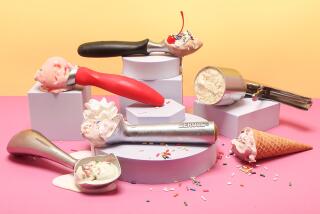Consistency Problems of Whipping Cream
- Share via
Question: Occasionally I have problems with whipping cream. In some instances it whips to a smooth peak but there are times when the same brand of cream takes forever to whip and when it finally thickens, it has a coarse, soft texture.
Answer: Other readers have also complained about the following problems in whipping cream: getting a cooked taste in the cream, some lumping in freshly bought cream even though the expiration date is far ahead, not getting a doubled volume after whipping and where to get cream that is not ultra-pasteurized.
Researchers Christine Bruhn, from the Center of Consumer Research at UC Davis, and her husband Dr. John Bruhn, of UC Davis Dairy Research, recently did some studies on whipping cream. They said that although ultra-pasteurization of whipping cream offers consumer advantages of increasing product shelf life it also has created several variables in the whipping quality of the product. Ultra-pasteurization is the process in which cream is rapidly heated to a temperature that kills virtually all organisms, making a sterile product. After doing some testing on the pasteurized and ultra-pasteurized products, Christine Bruhn talked about some of the test findings which could help answer some of the complaints.
Ultra-pasteurized cream has a slight cooked taste which becomes more pronounced the longer it is processed and the higher the processing temperature. Butterfat content, homogenizers, emulsifiers, stabilizers and temperature or coldness history also affect whipping.
The higher the butterfat (or milkfat) content the stiffer and thicker the cream becomes in less beating time. Therefore for the thicker-whip quality, heavy whipping cream, which has a butterfat content of not less than 36%, should be used. The overrun (volume increase after whipping) in heavy cream is lower though than that with less butterfat.
Light or regular whipping cream contains not less than 30% but less than 36% milkfat and so takes longer to whip. Restaurant chefs use manufacturer’s cream (not available retail) which could have up to 40% milkfat. This is the reason why chefs don’t encounter problems in whipping that the average consumer does.
The amount, kind and combination of emulsifiers and stabilizers used varied from one processor to another and as test results were inconsistent even for the same brand, there were no conclusive data gathered from these. Bruhn said, “There’s still a mystique in the processing of cream which already starts as a highly variable product. It’s a processor’s secret to produce a total package, similar to a chef’s secret of turning out a good souffle.”
Temperature is another factor. To whip well, the product should not undergo temperature changes just before whipping. For instance, cream that has traveled from a store to a home will not whip as well as cream that has been refrigerated at 40 degrees for at least 24 hours.
Lumping doesn’t indicate a spoiled product unless it tastes rancid and the sell-by-date on the package has expired. Changes in temperature from store to house and variances in stabilizers affect the smoothness of cream. To avoid lumping, always shake the cream carton before opening.
It is difficult to find cream that is not ultra-pasteurized in Los Angeles retail markets. In the Bay Area fresh pasteurized heavy cream (about 39 1/2% butterfat) is available from Berkeley Farms. This product has a refrigerated shelf life of 12 to 14 days. The only pasteurized heavy whipping cream I found in Los Angeles is sold by Ralphs grocery under the Ralphs label.
Q: Can you please provide some tips on whipping cream properly?
A: Here are some helpful tips on whipping cream from the American Dairy Assn.
When buying cream, it should be among the last purchases at the grocery store, then refrigerate it as soon as possible. Keep refrigerated at 40 degrees or lower in the closed carton.
One cup whipping cream usually yields 2 cups whipped cream. Do not whip more cream than is suitable for the beaters to handle. For this reason it is better to whip two half pints separately than a whole pint at once.
Use a bowl that is just large enough to hold the whipped cream, yet deep enough to accommodate the beaters and maintain good contact with the cream. Place the cream, bowl and beaters in the freezer for about 10 minutes before whipping.
Beat rapidly, scraping the bowl occasionally. It will take two to three minutes to whip cream until fluffy, but do not overwhip.
Whipped cream can be rewhipped one to two days following the original whipping. It can also be frozen in small mounds on wax paper for use as garnishes when needed.
Flo Braker, author of “The Simple Art of Perfect Baking,” (William Morrow and Co.: $24.95), recommends, “. . . no matter what method I choose to whip cream, I always finish the process by hand with a whisk. This gives me control over the cream’s finish, allowing me to stop and test for the desired degree of thickness. . . . It is important to be aware that even after the cream has been whipped to the desired consistency, any kind of manipulation--whether folding, filling a pastry bag, piping or spreading--will continue to thicken it.”
Address questions on food preparation to You Asked About, Food Section, The Times, Times Mirror Square, Los Angeles 90053. Personal replies cannot be given.
More to Read
Eat your way across L.A.
Get our weekly Tasting Notes newsletter for reviews, news and more.
You may occasionally receive promotional content from the Los Angeles Times.










